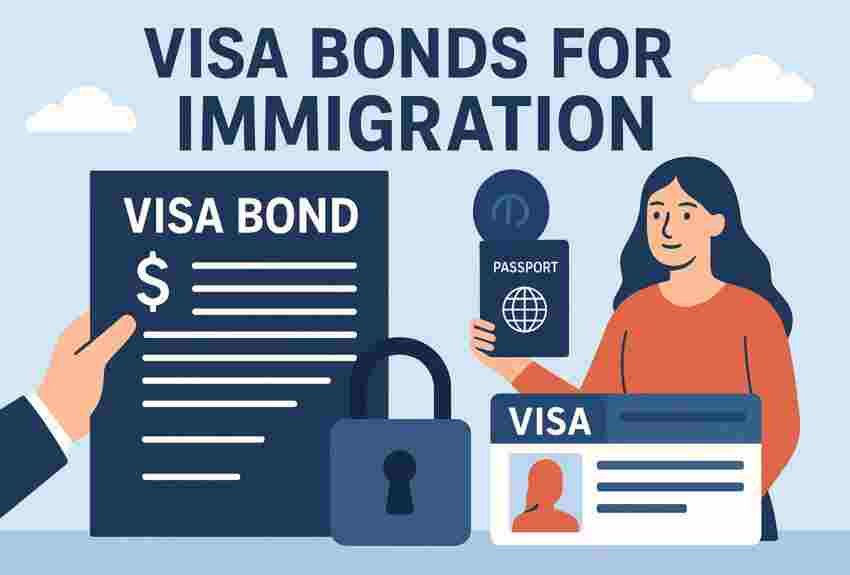
Visa bonds are financial guarantees some governments may require from travelers considered at risk of overstaying their visas. While originally proposed in limited cases like U.S. visitor visas, there’s growing debate around their impact on broader immigration policies. As of now, international students are generally not targeted—but changes could come in 2025. Let’s explore what this means.
What Are Visa Bonds?
Visa bonds are financial deposits paid by visa applicants to ensure they leave the country before their visa expires.
These bonds act as a guarantee. If the person overstays, the government keeps the money. If they leave on time, the bond is refunded. While not widespread, some governments have introduced or proposed visa bonds for high-risk nationalities or temporary visa holders.
In the U.S., for example, the Trump-era pilot program required a $5,000–$15,000 bond for certain B-1/B-2 visa holders from specific countries with high overstay rates. Though paused, the idea has not been entirely ruled out.
Are Visa Bonds Used for Student Visas?
Currently, no. Most countries do not require visa bonds for student visa applicants.
Student visa systems like F-1 in the US, Tier 4 in the UK or Subclass 500 in Australia—already involve strict vetting, documentation and financial proof. Because international students usually enroll through formal institutions, they are considered lower risk than casual tourists.
That said, some countries may revisit visa bond discussions if overstay rates increase or if student visas are misused for immigration purposes.
Could Visa Bonds Affect International Students in 2025?
Possibly, depending on changing immigration trends and policy reforms.
While no major government has officially proposed visa bonds for students in 2025, the political climate around immigration is shifting. Rising concerns about overstays, illegal work, and backdoor migration could pressure policymakers to impose stricter rules.
For example:
- If a country sees rising student visa overstays, it may introduce bonds to reduce risk.
- Increased scrutiny on post-study work programs might lead to bond-backed guarantees.
- Low-risk nationalities may be unaffected, while students from flagged countries might face stricter rules.
So far, there’s no confirmed policy requiring student visa bonds—but the conversation is evolving.
Why Are Visa Bonds Being Discussed More Lately?
Governments want to reduce visa overstays without denying access entirely.
Visa bonds are seen as a middle-ground policy:
- Instead of blanket visa bans, they allow access but with financial accountability.
- They shift the risk from governments to travelers.
- They signal tougher immigration controls without fully closing doors.
With rising migration debates, especially post-pandemic, visa bonds could be seen as a way to maintain openness while minimizing abuse.
What Should International Students Watch For in 2025?
Here are key things to track if you plan to study abroad in 2025:
- Changes to visa categories: Any updates to student visa rules (e.g., restrictions on post-study work, proof of intent to return).
- Announcements from immigration ministries: Especially in the US, UK, Canada, Australia, and EU countries.
- Consultation papers or pilot programs: Governments may test bond systems before enforcing them.
- Overstay reports by nationality: Countries may target nations with higher visa violations.
Students should also stay in touch with study-abroad counselors and check government immigration websites regularly.
What Can Students Do If Visa Bonds Are Introduced?
If such policies are enforced, here’s how to prepare:
- Budget for the bond: Treat it like a refundable security deposit. Make sure it’s from legal income sources.
- Track your stay and departure: Maintain documentation to prove you followed the rules.
- Keep all travel records and return flight details: Helpful for refund claims.
- Understand refund timelines and processes: Some countries may delay or tax refunds.
- Use official channels only: Avoid agents who ask for bond money in cash or make false promises.
Stubard Tip: Transparency Will Be Key
If visa bonds for students ever become a reality, clear communication from universities and consultants will matter more than ever. Stubard will track and explain all updates so you don’t face confusion or risk delays.
Planning to study abroad in 2025? Let Stubard help you navigate visa changes, scholarships, and admission updates with free counseling.
Conclusion
Visa bonds are a controversial and evolving topic—but for now, international students are not directly impacted. Governments may revisit these ideas in the future, but no major country has made bonds mandatory for study visas.
If you are planning to apply in 2025, focus on building a strong academic profile, following all immigration rules and staying informed through reliable sources like Stubard.
Frequently Asked Questions
1. What is a visa bond?
It’s a refundable deposit some countries require to ensure visa holders don’t overstay.
2. Do international students need visa bonds?
As of 2025, no major country requires visa bonds for student visas.
3. Why are visa bonds being discussed?
They help governments reduce visa overstays without banning applicants.
4. How much is a visa bond?
Amounts vary, but past programs required $5,000–$15,000.
5. Will visa bonds be introduced in the US for students?
There is no current plan, but future immigration changes are possible.
6. Can I get my bond money back?
Yes, if you follow visa rules and leave on time.
7. Which countries have tested visa bonds?
The US, UK, and some EU countries have considered or piloted them.
8. Are visa bonds like scholarships or deposits?
No. Bonds are a government-imposed guarantee—not financial aid.
9. Can agents misuse visa bond systems?
Yes. Only trust official channels or certified consultants like Stubard.
10. What should I do if visa bonds are introduced for my country?
Budget accordingly, follow official instructions, and keep all visa and travel records safe.
